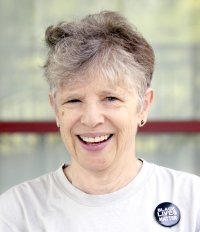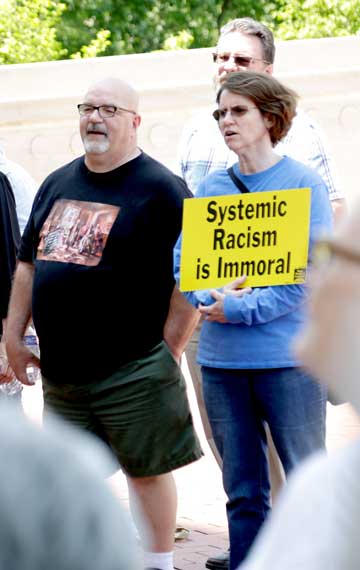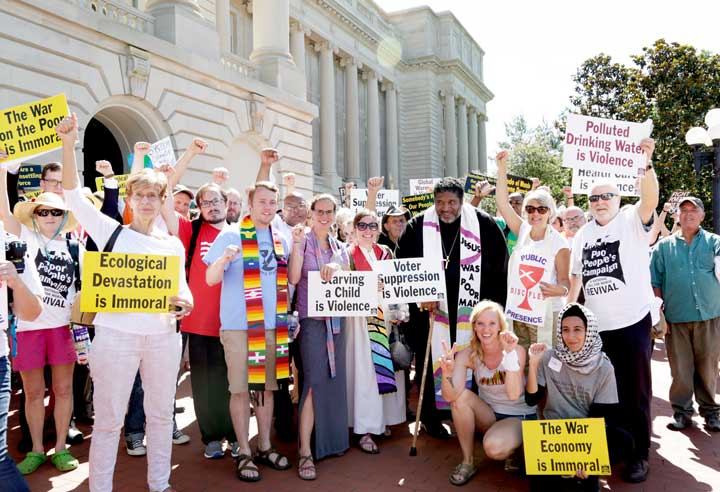The Poor People’s Campaign and KFTC share key goals

On a hot day last month, I stood in front of the state capitol building with hundreds of other Kentuckians, including many KFTC members. We were led that day by Reverend William Barber, the co-leader of the Poor People’s Campaign: A National Call for Moral Revival.
We wanted to enter the capitol to talk with officials and show our support for a Kentucky and nation that stands for all of us, not just the wealthy. But the door to the “People’s House” was closed to the “people,” although legislators and corporate lobbyists strolled past us and went straight through.
Although we vote and pay taxes, we were forbidden to enter the building that our taxes pay for.
Actually, the guards were willing to let us in, two-by-two. However, only one pair could go in at time. Until the first pair came back, no one else could enter. Since there were at least 400 of us, it would have taken two or three days for us all to enter.
I ask myself, what are they so afraid of? Their constituents? Irritating the big donors who fund their campaigns? Annoying Governor Bevin? I think that they’re basically afraid of democracy – a system of government in which the people rule, not the privileged few.
Like us, people in nearly 40 states rallied in front of – or in – their state capitols for six weeks in May and June. The Poor People’s Campaign called for mass actions, including civil disobedience, as part of its National Call for Moral Revival. Hundreds of people went to jail all over the country, except in Kentucky. We were the only state where the police refused to make arrests; instead, they prevented us from entering the state capitol at all.
 The culminating event of these actions was a rally in Washington on June 23 – around 100 Kentuckians joined in, many of whom rode all night on a bus paid for in part by KFTC. Organizing Apprentice Tanya Fogle gave a rousing speech in front of thousands. Tayna also is a co-coordinator of the Kentucky State Poor People’s Campaign.
The culminating event of these actions was a rally in Washington on June 23 – around 100 Kentuckians joined in, many of whom rode all night on a bus paid for in part by KFTC. Organizing Apprentice Tanya Fogle gave a rousing speech in front of thousands. Tayna also is a co-coordinator of the Kentucky State Poor People’s Campaign.
Today’s Poor People’s Campaign is inspired by the Poor People’s Campaign that took place 50 years ago. Planned by Dr. Martin Luther King Jr. and other Civil Rights Movement leaders, that campaign represented Dr. King’s growing awareness that systemic racism could not be addressed successfully without paying attention to the economic situation, particularly poverty.
As Dr. King began to give speeches on the connection between race and poverty, he became even more controversial. On top of his opposition to the Vietnam War, for promoting militarism over racial and economic justice, Dr. King seemed to be coming too close to challenging the basis of U.S. oppression.
By 1968 polls showed that two-thirds of the U.S. public disapproved of Dr. King. This is the radical King we hardly ever hear about. Instead, King is hailed once a year as the dreamer whose monument on the mall confirms that we now live in a “color-blind” society.
Before the original Poor People’s March took place, Dr. King was assassinated in April 1968. Still, the march took place, starting from Marks, Mississippi, then the poorest town in the nation. People walked, drove trucks and rode mules.
When they arrived in Washington the marchers set up Resurrection City, a tent city where they intended to stay until the government took real action to end poverty. Unfortunately, after only six weeks the encampment was taken down, and largely forgotten until the current Poor People’s Campaign gave it new life.
The Poor People’s Campaign today knows that colorblindness is just a mirage, that our society is nearly as segregated and unequal as it was 50 years ago. To take just one example, although Jim Crow has been officially confined to the past, mass incarceration, especially of African Americans and Latinx, functions as a system of social control every bit as effective as legal segregation.[1]
But even more than its predecessor, this Poor People’s Campaign recognizes the need for unity across all lines of difference – race, class, sex, sexuality, gender, ability, language and others. When we fight against each other, the only people who win are the powerful.
Moreover, the issues are intertwined. That’s why the campaign focuses on six interrelated crises: Systematic Racism; Poverty and Inequality; Ecological Devastation; War Economy and Militarism; and National Morality. In fact, each of the six weeks of protest leading up to the rally in Washington represented one of these themes in a general way. On the day that I went, we marched for an end to ecological devastation and for accessible, quality health care.
KFTC has been involved with the Poor People’s Campaign since almost the beginning. The Harlan County chapter organized one of Reverend Barber’s visits to Kentucky. The gathering was part of a national tour by co-chairs Reverend Barber and Rev. Liz Theoharis to learn about the different ways that poverty manifests itself around the country.
The Harlan gathering was a “community conversation” about Appalachia. The campaign highlighted the fact that the face of poverty is multicolored: white, black and brown. As a national leader in how to organize white people for social justice, KFTC has continued to provide support for the campaign, including the six weeks of action.
 There are strong parallels between KFTC’s goals and approach to organizing and the Poor People’s Campaign’s goals and approach. Our vision for Kentucky is very similar to the call of the Poor People’s Campaign for a nation that values all its people. Both our groups share a commitment to local and state power; although the Poor People’s Campaign is a national organization it chooses to lift up work at the grassroots.
There are strong parallels between KFTC’s goals and approach to organizing and the Poor People’s Campaign’s goals and approach. Our vision for Kentucky is very similar to the call of the Poor People’s Campaign for a nation that values all its people. Both our groups share a commitment to local and state power; although the Poor People’s Campaign is a national organization it chooses to lift up work at the grassroots.
One of the most important similarities between the campaign and KFTC is the belief in multi-issue organizing. In Kentucky, we have learned that focusing on a single issue is ineffective, because social justice issues are so interconnected.
Restoration of voting rights may seem very different from the pollution, but in fact both issues are driven by the idea of powerlessness. State officials get away with denying former felons the right to vote because the poor people and people of color most affected are seen as having little political power (a self-fulfilling prophecy – if you can’t vote, you don’t have power).
Every day I watch the news, I am assailed by the number of injustices that threaten to overwhelm us in our country and in our state. To fight back, and to move forward at the same time, we need to set aside our differences and act together. KFTC’s partnership with the Poor People’s Campaign is a critical step in that direction.
-----------
[1] Michelle Alexander, The New Jim Crow: Mass Incarceration in the Age of Colorblindness.

Recent News
Kentucky’s past legislative session showed alarming trend toward government secrecy
Churchill Downs takes more than it gives. That's why the Kentucky Derby is a no-go for me
‘We must never forget.’ Kentucky town installs markers for lynching victims.
Featured Posts
Protecting the Earth
TJC Rolling Out The Vote Tour – a KFTC Reflection Essay
KFTC Voter Empowerment Contractor Reflection Essay
Archives
- Home
- |
- Sitemap
- |
- Get Involved
- |
- Privacy Policy
- |
- Press
- |
- About
- |
- Bill Tracker
- |
- Contact
- |
- Links
- |
- RSS

